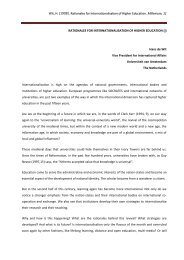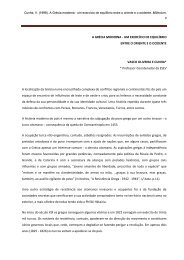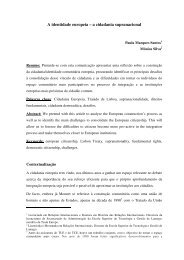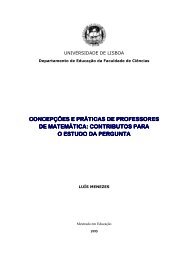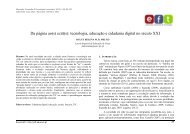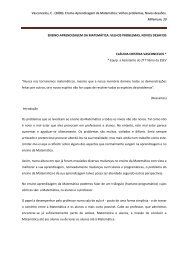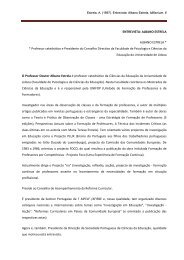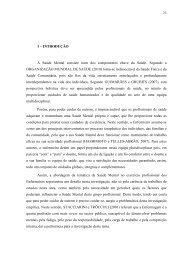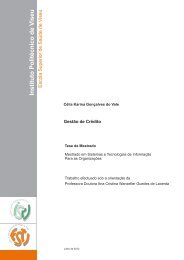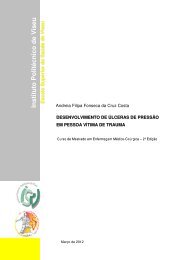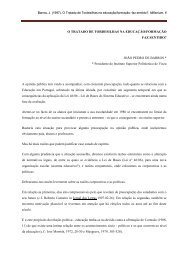Amino acid profile and Maillard compounds of sun-dried pears ...
Amino acid profile and Maillard compounds of sun-dried pears ...
Amino acid profile and Maillard compounds of sun-dried pears ...
Create successful ePaper yourself
Turn your PDF publications into a flip-book with our unique Google optimized e-Paper software.
642 Eur Food Res Technol (2011) 233:637–646Table 2 Protein amino <strong>acid</strong>scontent (mg 100 g -1 ) <strong>of</strong> 2009fresh <strong>and</strong> <strong>dried</strong> pear fruitsValues are mean ± st<strong>and</strong>arderror (3 replicates)Protein amino <strong>acid</strong>s content (mg 100 g -1 )<strong>Amino</strong> <strong>acid</strong> Fresh 09 Traditional 09 GH1 09 GH2 09 HAT 09Ala 15.21 ± 1.22 15.01 ± 0.62 18.94 ± 5.89 17.77 ± 2.55 11.10 ± 2.45Gly 9.11 ± 0.19 8.52 ± 0.06 10.24 ± 2.07 8.02 ± 2.71 8.47 ± 0.79Val 22.32 ± 2.24 21.58 ± 0.57 26.09 ± 0.34 23.30 ± 0.06 19.81 ± 3.05Thr 12.92 ± 1.17 10.50 ± 1.86 11.95 ± 0.61 9.78 ± 3.32 13.32 ± 0.61Leu 64.16 ± 11.64 58.52 ± 5.51 60.25 ± 12.11 66.22 ± 11.93 55.25 ± 4.44Ile 33.28 ± 10.71 29.82 ± 3.64 28.87 ± 0.69 38.28 ± 3.82 34.98 ± 4.74Pro 19.77 ± 6.82 9.22 ± 2.05 14.89 ± 3.12 4.76 ± 2.04 12.45 ± 0.65Asx 44.72 ± 12.23 41.48 ± 2.80 51.99 ± 8.96 49.99 ± 4.64 44.65 ± 2.32Phe 11.48 ± 2.68 9.01 ± 4.37 11.87 ± 0.11 12.45 ± 0.97 11.99 ± 1.02Glx 79.58 ± 13.87 93.48 ± 2.12 90.92 ± 12.39 83.84 ± 6.69 89.92 ± 8.16Lys 24.88 ± 1.13 19.34 ± 2.52 18.99 ± 6.59 23.53 ± 0.78 24.02 ± 3.25Total 337.43 ± 63.89 316.46 ± 13.47 345.98 ± 10.66 336.92 ± 25.21 325.97 ± 30.27amino <strong>acid</strong> in higher amount, followed by Glx. Consideringtheir relative molar percentages, Pro accounts for39–25% <strong>of</strong> the free amino <strong>acid</strong>s, whereas Glx accounts for24–15%. Although no data are available for free amino<strong>acid</strong>s <strong>of</strong> <strong>dried</strong> <strong>pears</strong>, the results are comparable with thoseobtained for the dehydration <strong>of</strong> grapes where it wasobserved the decrease in the total free amino <strong>acid</strong> contentas well as a decrease in Asx [11]. These authors attributedthe decrease in the free amino <strong>acid</strong> content to the low wateractivity <strong>of</strong> samples, favouring the <strong>Maillard</strong> reaction atroom temperature. Also, the higher relative amount <strong>of</strong> freePro has been observed in pear juice [14]. In fact, theincrease in the synthesis <strong>of</strong> Pro has been reported as aresponse <strong>of</strong> the fruits to stress conditions [19, 26, 27],namely due to the modulation <strong>of</strong> expression <strong>of</strong> proline-richglycoproteins (extensins).Eleven amino <strong>acid</strong>s were found in proteins from fresh<strong>and</strong> traditional <strong>sun</strong>-<strong>dried</strong> <strong>pears</strong> (Table 2; Fig. 2b). In total,they account for 4.23 mg per g <strong>of</strong> dry weight <strong>of</strong> the pulp inthe samples from fresh fruits in 2008 season <strong>and</strong>3.37 mg g -1 in 2009. A value <strong>of</strong> 2.31 mg g -1 (dry weight)for fresh pear (Pyrus communis L.) is reported in literature[7], although from Beurré variety, which is lower than thevalues for protein found for S. Bartolomeu fruits from bothharvests. In traditional <strong>sun</strong>-<strong>dried</strong> fruits, the amount <strong>of</strong>protein amino <strong>acid</strong>s was higher (18%) than in fresh in 2008(5.00 mg g -1 ) <strong>and</strong> lower (6%) in 2009 (3.17 mg g -1 ).For the fresh fruits, the most abundant protein amino<strong>acid</strong>s are Glx <strong>and</strong> Leu (20–19 mol%, each) <strong>and</strong> Asx(17–13 mol%) (Fig. 2b). Also in relevant amount occur Ile(10–7 mol%), Ala (8–7 mol%) <strong>and</strong> Val (7 mol%). Asx wasreported by Pilipenko et al. [7] as the predominant amino<strong>acid</strong> in Pyrus communis L. fruits <strong>of</strong> Beurré variety(35 mol%), showing that S. Bartolomeu <strong>pears</strong> present lowerrelative amounts, although similar amounts are observedwhen expressed in mg g -1 . All amino <strong>acid</strong>s found as constituents<strong>of</strong> S. Bartolomeu <strong>pears</strong> have been also found inBeurré variety. The exception is Hyp, not found in amountsto be detected in S. Bartolomeu <strong>pears</strong>. Hyp is an amino <strong>acid</strong>characteristic <strong>of</strong> extensins <strong>and</strong> arabinogalactan-rich glycoproteins.Pyrus communis L. arabinogalactan-rich glycoproteinsfrom suspension cultures are composed mainly byGlx (16 mol%) [28]. In Chinese species, reporting eightpear varieties, Chen et al. [8] showed large variations in theamino <strong>acid</strong> <strong>pr<strong>of</strong>ile</strong> for the different pear varieties. Anyway,Asn accounted for near 20% <strong>of</strong> total amino <strong>acid</strong>s. In these<strong>pears</strong>, Ser is the main constituent, although not always,which is not the case <strong>of</strong> Pyrus communis L., where no Serwas found.No significant changes were observed in the amino <strong>acid</strong>s<strong>pr<strong>of</strong>ile</strong> <strong>of</strong> proteins from traditional <strong>sun</strong>-<strong>dried</strong> <strong>pears</strong> whencompared to the fresh samples (Fig. 2b). However, inrelation to the same mass <strong>of</strong> protein, a decrease in thecontent <strong>of</strong> Pro (-16% in 2008 <strong>and</strong> -50% in 2009), Phe(-15 <strong>and</strong> -16%), Lys (-9 <strong>and</strong> -17%) <strong>and</strong> Thr (-10 <strong>and</strong>-13%) was observed in both harvests, contrasting with theincrease in Glx (?17 <strong>and</strong> ?25%). The higher differencewas Pro, in accordance with the higher increase in Pro foundas free amino <strong>acid</strong>. Also, the increase in the content in Glxin proteins is in accordance with the lower amounts found asfree amino <strong>acid</strong>. As no data are available concerning thecomposition <strong>of</strong> the amino <strong>acid</strong>s <strong>of</strong> proteins <strong>of</strong> <strong>dried</strong> fruits,the origin <strong>of</strong> this phenomenon remains unknown, althoughit can be suggested that modulation in Pro-rich glycoproteinsynthesis <strong>and</strong>/or degradation seems to be involved. Concerningthe decrease in Phe, Lys <strong>and</strong> Thr, it is possible that itis related with the occurrence <strong>of</strong> <strong>Maillard</strong> reactions. Thishypothesis will be verified taking into account the analysis<strong>of</strong> other independent samples, namely the <strong>pears</strong> <strong>dried</strong>according to different methodologies, which present123




